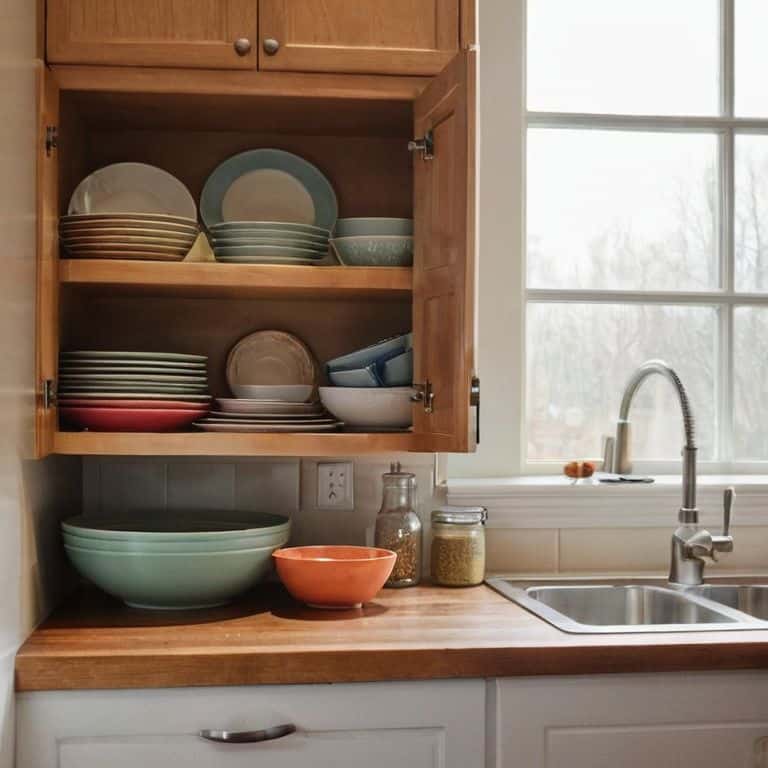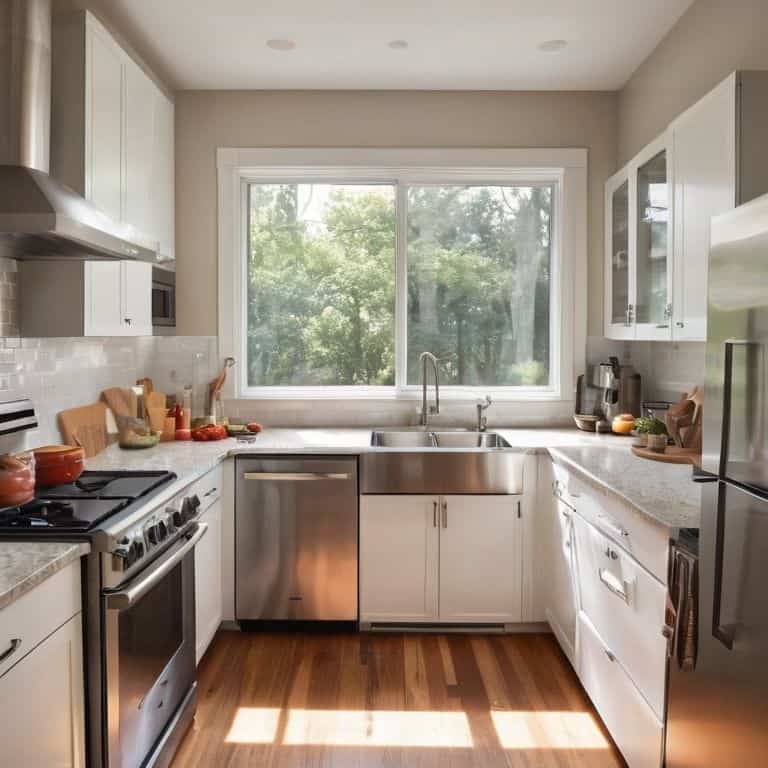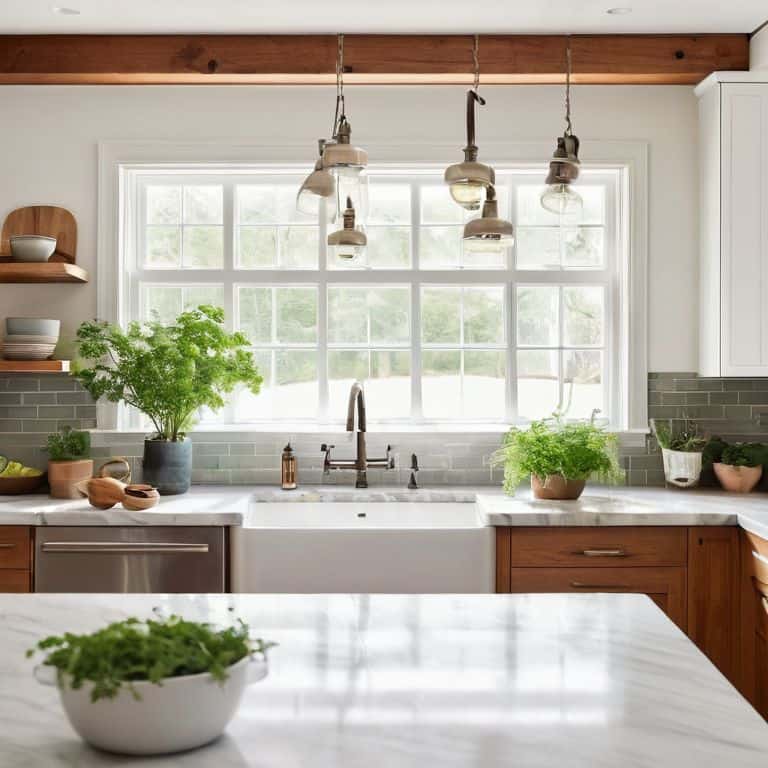I still remember the day I realized that my kitchen, despite being a beautiful space, was actually hindering my cooking experience. I was trying to prepare a simple dinner, but the clutter and chaos were overwhelming. That’s when I decided to tackle the question of how to organize your kitchen. It’s a challenge many of us face, and it’s not just about aesthetics; a well-organized kitchen can make all the difference in our cooking habits and overall well-being. I’ve seen it time and time again – a cluttered kitchen can lead to stress, wasted time, and a lack of inspiration in the culinary department.
As someone who’s passionate about creating functional and beautiful spaces, I’m excited to share my expertise with you. In this article, I’ll provide you with practical tips and tricks on how to transform your kitchen into a haven of efficiency and calm. We’ll dive into the importance of the _kitchen work triangle_, discuss strategies for optimizing your storage and workflow, and explore ways to create a visually appealing space that sparks joy and creativity. Whether you’re a seasoned chef or a culinary newbie, this guide will help you create a kitchen that supports your cooking style and makes the process of preparing meals a pleasure, not a chore.
Table of Contents
- Guide Overview: What You'll Need
- Step-by-Step Instructions
- How to Organize Your Kitchen
- Efficient Workflow Strategies for a Calm Kitchen
- Maximizing Storage Space With Custom Cabinet Solutions
- 5 Essential Tips to Transform Your Kitchen into a Haven of Efficiency
- Key Takeaways for a Harmonious Kitchen
- The Heart of a Harmonious Kitchen
- Bringing It All Together: Your Dream Kitchen Awaits
- Frequently Asked Questions
Guide Overview: What You'll Need

Total Time: 2 hours 30 minutes
Estimated Cost: $50 – $100
Difficulty Level: Intermediate
Tools Required
- Measuring Tape (for measuring cabinets and shelves)
- Level (for ensuring proper alignment)
- Drill (with screwdriver and drill bits)
- Screwdriver (flathead and Phillips)
- Pencil and Paper (for planning and notes)
Supplies & Materials
- Shelves (adjustable or fixed, depending on needs)
- Storage Bins (plastic or wooden, various sizes)
- Hooks (for hanging items like pots, pans, or utensils)
- Adhesive Hooks (for hanging items on the back of doors or walls)
- Label Maker (for labeling storage containers and shelves)
- 2 inches by 4 inches Lumber (for building custom shelves or supports)
- Wood Screws (for assembling shelves or other wooden structures)
Step-by-Step Instructions
- 1. First, let’s start with the purge and declutter process – it’s essential to get rid of any items you no longer need or use. Begin by taking everything out of your cabinets, drawers, and countertops, and sort items into three categories: keep, donate/sell, and discard. Be ruthless – if you haven’t used it in the past year, it’s probably safe to get rid of it.
- 2. Next, assess your kitchen’s layout and identify the areas that need the most attention. Consider the kitchen work triangle, which connects the sink, stove, and refrigerator – this is the most critical area of your kitchen, and it should be as efficient as possible. Take note of any obstacles or bottlenecks in this triangle and plan to address them.
- 3. Now it’s time to categorize and group similar items together. This will make it easier to decide where to store them and how to access them quickly. For example, group all your baking supplies together, including flour, sugar, and baking powder, and consider storing them in a designated baking station.
- 4. Once you have your categories and groups, it’s time to assign a home for each item. This means designating a specific place for each item, such as a specific cabinet or drawer, and making sure it’s easily accessible. Consider using labels and signs to help you and others quickly identify where things are stored.
- 5. To maximize your kitchen’s storage potential, consider installing shelves or a pot rack. This will help keep your countertops clear and provide a place to store infrequently used items, such as special occasion dishes or cookbooks. Just be sure to measure carefully to ensure that your new shelves or rack fit comfortably in the space.
- 6. Another essential step is to optimize your pantry. This means using stackable containers to store dry goods, such as pasta, rice, and cereal, and considering a pantry organizer system to help keep everything tidy and easily accessible. Don’t forget to check expiration dates and get rid of any expired or stale items.
- 7. Finally, let’s talk about maintaining your newly organized kitchen. This means setting aside time each week to wipe down surfaces, sweep and mop the floor, and check your storage systems to make sure everything is still in its assigned place. By doing so, you’ll be able to keep your kitchen organized and functional, and make cooking and meal prep a breeze.
How to Organize Your Kitchen

As I always say, a well-designed kitchen layout design is the backbone of a functional cooking space. To achieve this, it’s essential to consider the _work triangle_, which connects the sink, stove, and refrigerator. By positioning these elements in a way that minimizes walking distances, you’ll be able to move seamlessly through your kitchen, making cooking a breeze.
When it comes to maximizing storage space, custom cabinet solutions can be a game-changer. I like to think of kitchen cabinets as the ultimate _storage superheroes_, keeping clutter at bay while maintaining a sleek aesthetic. By investing in custom cabinets that fit your unique kitchen layout, you’ll be able to optimize your storage capacity and keep frequently used items within easy reach.
To take your kitchen organization to the next level, try decluttering kitchen countertops by implementing efficient workflow strategies. This might involve designating specific zones for food preparation, cooking, and cleaning, or investing in clever storage solutions like spice racks or utensil organizers. By streamlining your workflow and minimizing clutter, you’ll be able to focus on what really matters – cooking up a storm in your beautifully organized kitchen!
Efficient Workflow Strategies for a Calm Kitchen
To achieve a calm kitchen, it’s essential to consider the workflow. I always emphasize the importance of the ‘kitchen work triangle’ – the path between your sink, stove, and refrigerator. By minimizing the distance between these points, you’ll reduce chaos and make cooking more enjoyable. For example, placing your most frequently used utensils and ingredients near this triangle can save you time and energy.
By implementing efficient workflow strategies, you’ll be able to move seamlessly through your kitchen, focusing on the joy of cooking rather than navigating obstacles. Consider the tasks you perform most often, such as food preparation or cleaning, and optimize your layout accordingly. This thoughtful approach will help you create a kitchen that feels like a sanctuary, where you can unwind and express your creativity.
Maximizing Storage Space With Custom Cabinet Solutions
To truly maximize storage space, I always recommend exploring custom cabinet solutions. This is where the magic happens, and your kitchen can transform from cluttered to curated. By designing cabinets that fit your specific needs, you can make the most of often-wasted spaces, like corners or narrow walls. For instance, a custom pegboard can keep your most-used utensils and tools within easy reach, while a pull-out spice rack can keep your seasonings organized and visible.
Investing in custom cabinets may seem like a luxury, but trust me, it’s a game-changer. Not only will it enhance the aesthetic of your kitchen, but it will also create a more efficient workflow. Plus, with the right design, you can even incorporate clever features like hidden drawers or appliance garages to keep your countertops clear and clutter-free.
5 Essential Tips to Transform Your Kitchen into a Haven of Efficiency
- Start by decluttering your kitchen, getting rid of any unnecessary items that are taking up valuable space and making it harder to focus on cooking
- Implement the kitchen work triangle, where your stove, sink, and refrigerator form the points of a triangle to minimize walking distance and maximize efficiency
- Invest in a pegboard for your walls to hang frequently used utensils and tools, keeping them within easy reach and freeing up drawer space
- Use stackable containers and baskets to store dry goods, such as pasta, rice, and canned goods, and label them clearly so you can easily find what you need
- Install under-cabinet lighting to illuminate your countertops and make food preparation easier, while also adding a touch of warmth and ambiance to your kitchen
Key Takeaways for a Harmonious Kitchen
Tame the chaos by establishing a ‘kitchen work triangle’ that connects your sink, stove, and refrigerator, ensuring a fluid workflow and reducing unnecessary steps
Maximize your storage space with custom cabinet solutions and clever shelving ideas, keeping your countertops clear and your mind at ease
Prioritize efficient lighting, from warm ambient tones to focused task lighting, to create an inviting atmosphere that inspires creativity and makes cooking a joy
The Heart of a Harmonious Kitchen
A kitchen is not just a space, it’s a sanctuary where love, laughter, and memories are crafted – and it all begins with the intentional act of organizing your kitchen to nurture your soul, as much as it nurtures your body.
Clara Wu
Bringing It All Together: Your Dream Kitchen Awaits

As we’ve explored the world of kitchen organization, it’s clear that creating a space that inspires culinary bliss is within reach. From maximizing storage space with custom cabinet solutions to implementing efficient workflow strategies, every element plays a crucial role in transforming your kitchen into a haven. By applying these principles, you’ll not only enhance the aesthetic appeal of your kitchen but also significantly improve its functionality. Whether you’re a seasoned chef or a culinary newbie, a well-organized kitchen is the key to unlocking your full cooking potential.
As you embark on this journey to organize your kitchen, remember that it’s not just about rearranging cabinets or clearing countertops – it’s about crafting a space that nurtures your creativity and fosters a deep connection with the food you prepare. By embracing the art of kitchen design, you’re not only improving your cooking experience but also investing in the well-being of yourself and your loved ones. So, take a deep breath, roll up your sleeves, and let the transformation begin – your dream kitchen, and all the delicious memories it will hold, are waiting for you.
Frequently Asked Questions
What are some creative ways to repurpose existing kitchen items to reduce clutter and increase storage?
I love repurposing items to breathe new life into a kitchen. Consider turning an old mason jar into a utensil holder, or using a vintage ladder as a pot rack. You can also transform a wooden crate into a kitchen island or use glass jars to store dry goods, keeping your countertops clutter-free and your kitchen organized.
How can I determine the optimal layout for my kitchen to improve workflow and efficiency?
To determine the optimal layout, I always start by mapping out the ‘kitchen work triangle’ – the path between your sink, stove, and refrigerator. Consider your cooking habits and the tasks you perform most often, then arrange your space to minimize walking distances and maximize ease of movement.
What are some budget-friendly solutions for organizing kitchen utensils and gadgets without breaking the bank?
For budget-friendly solutions, I swear by repurposing items like mason jars, wooden crates, or vintage containers to store utensils and gadgets. You can also find affordable organizer trays and dividers at thrift stores or online marketplaces, giving your kitchen a stylish and functional touch without breaking the bank.
